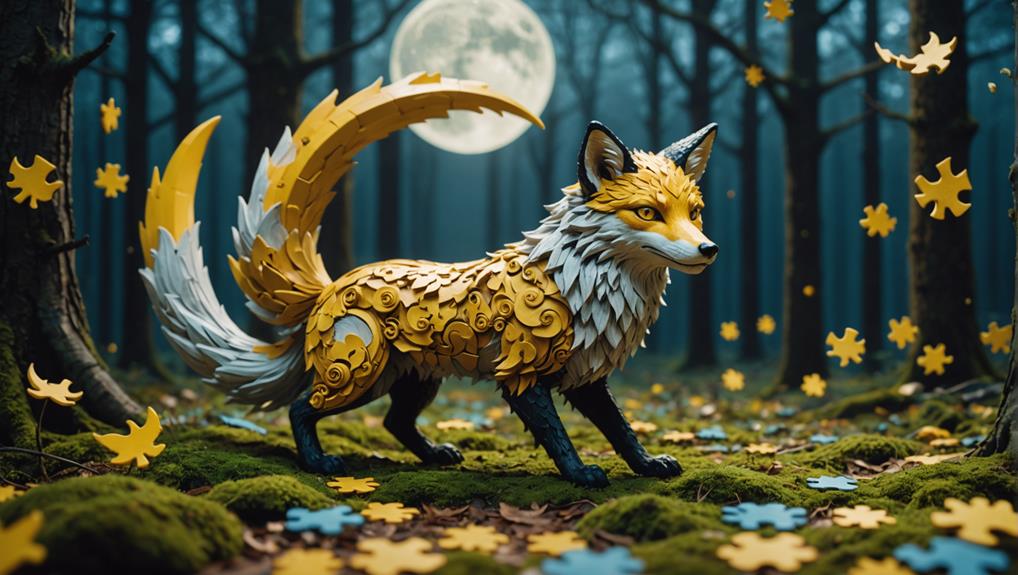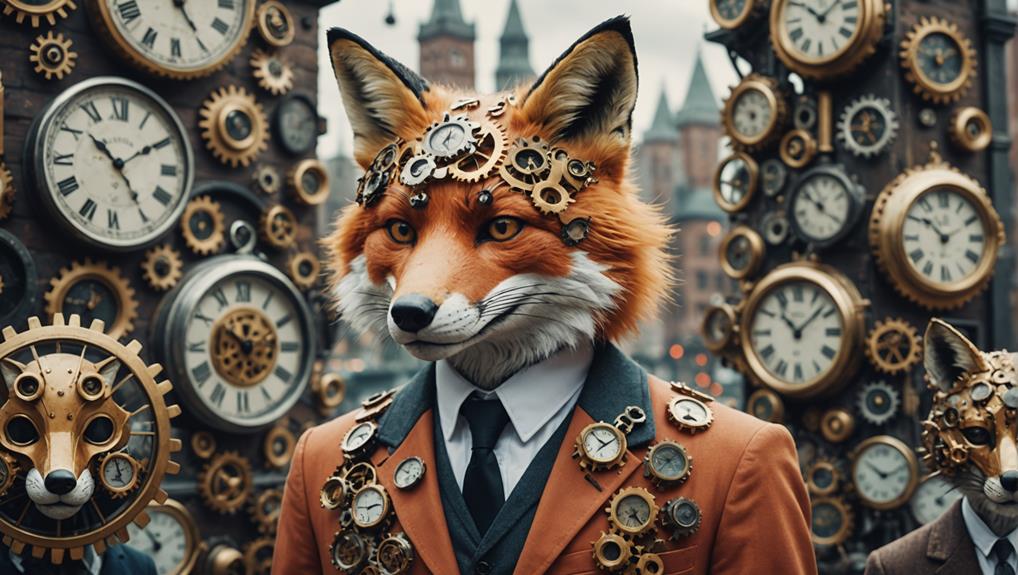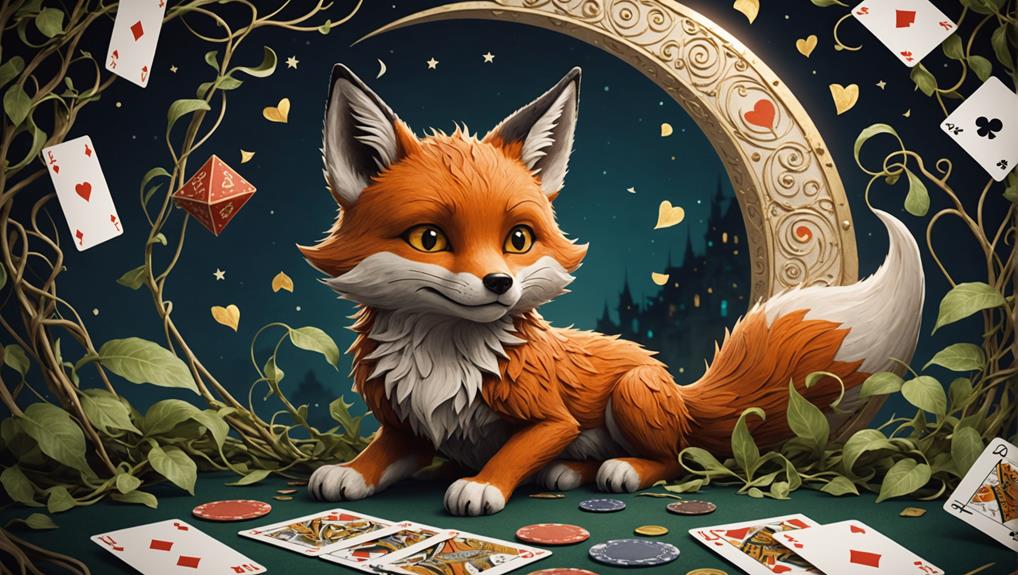You're probably wondering why trickster figures are often associated with foxes, right? Well, it's because foxes represent cleverness, adaptability, and resourcefulness, making them the perfect symbol for navigating complex social situations and imparting moral lessons. Across cultures, from Native American folklore to Celtic mythology, foxes have been depicted as shapeshifters, teaching wisdom and consequences of arrogance. Their cunning nature is a reflection of human ingenuity and resourcefulness, making them a popular choice for storytelling. And the more you explore the symbolism of the fox, the more you'll discover just how much they can reveal about our own nature and the world around us.
Contents
- 1 Foxes as Trickster Figures in Mythology
- 2 Symbolism of the Fox Across Cultures
- 3 Intelligence and Cunning: Traits of the Fox
- 4 Foxes in Folktales and Stories
- 5 The Role of Adaptability in Trickster Behavior
- 6 Reflections on the Fox as a Trickster Figure
- 7 Cultural Significance of the Fox Today
- 8 Final Thoughts
Foxes as Trickster Figures in Mythology
In many cultures, you'll find foxes playing the role of trickster figures, and for good reason. They symbolize cleverness, adaptability, and resourcefulness, making them the perfect embodiments of the trickster archetype.
In mythology, the fox's ability to shapeshift allows it to navigate complex social situations, often outsmarting others with its cunning. As a trickster figure, the fox imparts moral lessons through playful cunning, showcasing its strategic thinking and wisdom.
From Native American folklore to Celtic mythology, the fox's trickster nature is evident.
In Asian cultures, the kitsune, a fox spirit, represents both benevolence and malevolence, further solidifying the fox's reputation as a master trickster.
By embodying human complexities, the fox serves as a reflection of ourselves, highlighting our own capacity for cleverness, adaptability, and resourcefulness.
Through the fox's trickster figure, we're reminded to approach life with a sense of humor, wit, and strategic thinking, making it an endearing and relatable symbol across cultures.
Symbolism of the Fox Across Cultures
Cultural tapestries are woven with symbolic threads, and the fox's cunning nature is a common motif that runs deep. Across cultures, the fox embodies cleverness, shapeshifting, and adaptability, making it a powerful symbol in various mythologies and folklores.
As you delve into the symbolism of the fox, you'll discover:
- In Native American tales, the fox is a trickster companion to the Coyote, teaching wisdom and the consequences of arrogance.
- Celtic mythology portrays the fox as a shapeshifter, navigating between physical and spiritual realms with ease.
- In East Asian traditions, fox spirits like the Huli Jing and Kitsune are known for their shapeshifting abilities and dual nature, capable of benevolence or malevolence.
- Literary and artistic depictions of foxes illustrate complex human traits, moral lessons, and the fine line between cleverness and deceit.
- The fox's cunning nature is a reflection of human ingenuity and resourcefulness, making it a relatable and intriguing symbol.
The fox's symbolism transcends cultural boundaries, speaking to universal human experiences and emotions. As you explore the symbolism of the fox, you'll uncover the complexities and nuances of human nature.
Intelligence and Cunning: Traits of the Fox

As you explore the symbolism of the fox, you'll find that its intelligence and cunning are traits that consistently emerge across cultures.
These characteristics are deeply rooted in the fox's ability to adapt to different environments and situations, making it a master of survival. For instance, species like the Arctic fox have developed unique adaptations for extreme cold, showcasing their clever survival strategies in harsh conditions unique adaptations.
In folklore, the fox is often depicted as a trickster figure, using its wits to outsmart more powerful adversaries. This cleverness is showcased in famous fables like Aesop's "The Fox and the Grapes," where the fox's deceptive behavior serves as a moral lesson about pride.
The fox's reputation for cunning is well-deserved, as it can manipulate and navigate complex social dynamics with ease.
This quick wit helps the fox survive and thrive in a variety of situations. As a symbol of cleverness, the fox represents both wisdom and deception, highlighting its dual nature as a trickster figure.
Its intelligence and cunning make it a formidable opponent, and its ability to outsmart others has led to its widespread association with trickster figures across cultures.
Foxes in Folktales and Stories
Delve into the realm of folklore and you'll discover that foxes have been spinning tales and weaving magic for centuries, their cunning and cleverness captivating audiences worldwide. Their ability to outsmart opponents and showcase cleverness has led to their widespread depiction as trickster figures in global folklore.
In various cultural narratives, you'll find foxes in popular tales and stories, often symbolizing intelligence, adaptability, and strategic thinking. Here are a few examples that'll transport you to a world of wonder:
- In Aesop's Fables, the fox embodies deception, teaching valuable lessons about morality and wit.
- In Native American mythology, the fox accompanies Coyote, either helping or punishing those who display arrogance.
- Celtic fox mythology presents the fox as a shapeshifter, bridging the human and animal worlds with ease.
- East Asian folklore features fox spirits with shapeshifting abilities, often using their cunning to seduce or deceive humans.
- In Medieval literature, Reynard the Fox emerges as a symbol of rebellion and cleverness, highlighting the fox's association with trickery and moral ambiguity.
These stories showcase the fox's remarkable ability to captivate audiences, making them a staple in folklore and mythology.
The Role of Adaptability in Trickster Behavior

You've likely noticed that foxes in folklore and mythology often outsmart their opponents, showcasing cleverness and cunning. This is largely due to their remarkable adaptability, which allows them to navigate and manipulate various situations to their advantage.
Red foxes inhabit diverse environments such as forests, grasslands, and urban areas, illustrating their remarkable adaptability as they thrive in both rural and human-influenced spaces. In folklore, foxes frequently employ cunning strategies to outsmart more formidable adversaries, reinforcing their role as deceptive but clever creatures.
Across cultures, foxes exemplify a profound ability to thrive in diverse environments, demonstrating resilience and resourcefulness that align with the traits of a trickster. As a result, the fox's adaptability often reflects a deeper wisdom, enabling it to act as a guide or teacher in the face of challenging circumstances.
This dual nature of cunning and charm allows the fox to shape-shift between adversary and ally, serving as an important narrative device that underscores the significance of adaptability in trickster tales. By embracing adaptability, the fox embodies the essence of a trickster figure, making it an enduring and fascinating character in mythology.
Reflections on the Fox as a Trickster Figure
As you explore the world of trickster figures, you'll find that the fox is a recurring character, symbolizing cleverness and cunning across various cultures.
From outsmarting adversaries in folklore to challenging arrogance in Native American traditions, the fox's trickster archetype has evolved to reveal moral lessons about human nature.
Now, let's examine the significance of fox folklore and how it has shaped our understanding of this enigmatic creature.
Fox Folklore Significance
Renowned for their cunning and cleverness, foxes have earned a revered status as trickster figures across various cultures. You can find them in Native American folklore, Celtic mythology, and East Asian legends, always playing the role of the sly and clever one.
- Imagine a fox outsmarting other animals in Native American tales, teaching valuable lessons about humility and honesty.
- Picture a cunning fox shapeshifting into human form in Celtic mythology, showcasing its adaptability and wit.
- Envision a kitsune or huli jing in East Asian folklore, embodying the dual nature of tricksters, where benevolence and malevolence coexist.
- Think of a fox in literature and media, symbolizing deception, cleverness, and moral exploration through playful narratives.
- Recall how the fox's trickster nature is reinforced in stories, where it often embodies themes of cleverness, deception, and moral lessons.
In these stories, the fox folklore significance shines through, reflecting its role as a universal trickster figure.
Trickster Archetype Evolution
The fox's adaptability to diverse cultural narratives has contributed to the evolution of the trickster archetype, revealing its multifaceted nature across various mythologies and folklore.
You've likely noticed that foxes are universally recognized as trickster figures, thanks to their cunning and ability to outsmart larger adversaries in folklore. This cleverness has led to the fox playing different roles in various cultures, from helper to punisher in Native American mythology, to shapeshifter in Celtic mythology.
The Kitsune in Japanese folklore takes this adaptability to the next level, serving as either a benevolent protector or mischievous deceiver.
Through literature like "Reynard the Fox," the fox's trickster qualities are used to critique human behavior and societal norms, solidifying their status as emblematic tricksters.
As you explore the fox's role in cultural narratives, you'll see how its shapeshifting abilities and cunning nature have shaped the trickster archetype, making it a complex and intriguing figure.
Cultural Significance of the Fox Today

Many contemporary narratives feature foxes as central characters, leveraging their symbolic duality to captivate audiences. You're probably familiar with foxes as cunning villains or lovable heroes in popular culture. But their significance goes beyond storytelling. Urban foxes, for example, symbolize adaptability, thriving in diverse environments, from forests to urban landscapes, showcasing their resilience in contemporary settings.
Their role in controlling urban rodent populations and contributing to ecological balance underscores their importance in modern ecosystems urban foxes' ecological role.
- Foxes symbolize adaptability, thriving in diverse environments, from forests to urban landscapes.
- Conservation efforts highlight their ecological importance in maintaining balanced ecosystems.
- The fox's cleverness and charm are utilized in branding and merchandise, appealing to consumers.
- Modern discussions surrounding fox hunting spark debates on wildlife management and animal rights.
- Artistic representations of foxes evoke themes of cunning and intelligence, critiquing human traits and behaviors.
As you explore the cultural significance of foxes today, you'll notice their adaptability shines through in various aspects of popular culture. Their symbolic duality continues to captivate audiences, making them a compelling subject in modern narratives.
Final Thoughts
As you wander through the world of mythology, you'll find foxes frolicking in the shadows, flaunting their cunning charm. With their fiery furtiveness and adaptable asterisks, they've earned their stripes as trickster figures. From folklore to modern tales, the fox's fantastical flair has fascinated us, reminding us that wit and wisdom can be wrapped in a whirlwind of mischief and mayhem. So, the next time you cross paths with a cunning fox, remember: their cleverness is contagious, and their legacy lives on, forever fascinating and foxily fantastic.














